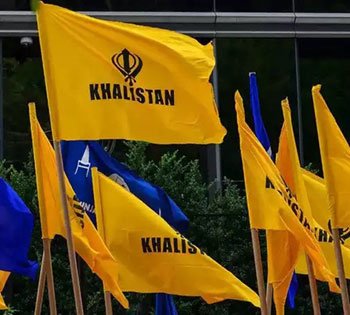|
Listen to article
Getting your Trinity Audio player ready...
|

Activists for an independent Khalistan have successfully made this chimera a political issue in Canada, though the idea has little resonance in India’s Punjab that is supposed to be its heartland. The project, according to Terry Milewski of the Macdonald-Laurier Institute, is funded by “thugs and political hustlers” in Canada, while Pakistan perverts the Sikh faith and creates false narratives of victimization, persecution and genocide. The November 2020 “referendum” aimed to give heft to this campaign but had to be postponed due to the tepid response that was attributed to the COVID pandemic. Officially, Canada has said it will not recognise the referendum.
In October 1992, Punjab police killed Canadian citizen Talwinder Singh Parmar and five accomplices in a shootout in Kang Araian village, Phillaur, Jalandhar district. Parmar was the mastermind behind the bombing of Air India’s flight 182 from Montreal to Heathrow in June 1985 that took the lives of 329 persons. Another bomb exploded on the ground at Japan’s Narita airport and killed two baggage handlers. Parmar’s presence in a Punjab village was proof that Pakistan had given refuge to the leader of the Air India plot. Two non-Sikhs who died with him turned out to be Muslims with Pakistani passports and were traced back to Pakistan’s Inter-Services Intelligence service (ISI).
Conceived by Zulfikar Ali Bhutto, the project was nurtured by General Zia-ul-Haq. Husain Haqqani, a former Pakistani envoy to Washington, observed that while “bleeding” India was the principal motive, Khalistan also aimed to create a strategic “buffer” between India and Pakistan and “end India’s land access to Kashmir.”
Canada has long been a haven for Sikh separatists. But when Talwinder Parmar fled Canada, he landed up in Pakistan. Khalid Awan, a Canadian of Pakistani descent and an avid supporter of Khalistan, was convicted by a federal jury in New York (US Attorney’s Office 2006) of giving aid to the Khalistan Commando Force, a terrorist group responsible for thousands of killings. Another Canadian citizen, Satinderpal Singh Gill, from Surrey, BC, lived for years in Pakistan as a senior official of the International Sikh Youth Federation that is banned as a terrorist organization in India, Canada, the UK and the US, but not in Pakistan. Two other Canadians, Bhagat Singh Brar and Parvkar Singh Dulai, were put on a government no-fly list after Canadian Security Intelligence Service accused them of aiding Khalistani terrorist activities in India.
Milewski (“Khalistan: A Project of Pakistan”) states that Pakistan’s role in nurturing the cause of Khalistan goes back to India’s partition in 1947 when Punjab was divided between India and Pakistan. The 1941 census (Punjab Partition Forum 2018) showed that Muslims comprised the majority (53 per cent), Hindus (29 per cent) and Sikhs (15 per cent). But the mass migrations triggered by partition took a heavy toll on the Sikhs; even today their survival is precarious in Pakistan, with forced conversions, attacks on gurdwaras and growing discrimination against all religious minorities.
Despite the torment of the Sikh minority in Pakistan, Sikhs For Justice’s activist-lawyer, Gurpatwant Singh Pannun, swears fealty to Pakistan. In fact, after openly supporting China in the border dispute with India, he wrote to Pakistani Prime Minister Imran Khan, promising that, “if India ever attacked Pakistan, the pro-Khalistan Sikhs will extend full support to Pakistan.” The assurance has little meaning as “Khalistan” cuts little ice in India’s Punjab, despite its Sikh majority.
As Prime Minister of India (2004-14), Dr Manmohan Singh, a Sikh whose family was forced to migrate to India, condemned Sikh extremism during a visit to Toronto in 2010. Singh admonished that there are “some elements outside India, including in Canada, who try to keep this issue alive for their own purposes. In many cases, such elements have links to or are themselves wedded to terrorism.” In 2017, Punjab elected the anti-separatist Congress leader, Capt. Amarinder Singh, as Chief Minister. A splinter group of the Shiromani Akali Dal that supported the separatists was rebuffed with 0.32 per cent votes.
Amarinder Singh accused Canadian Prime Minister Justin Trudeau of including Sikh separatists in his cabinet. In 2019, Singh called for UN sanctions against Canada for failing to crack down on the Khalistan movement, stating, “India had, for too long, been soft towards Canada and needed to crack its whip aggressively, even seek UN sanctions if needed, to end the growing threat once and for all.”
It bears stating that the dozen-odd years of Sikh insurgency that finally ended in 1993 took 21,469 lives and most victims (civilian, police, or terrorist) were Sikh. They included journalists, police (1400, plus many family members), judges, farmers, teachers, bankers, and even newspaper delivery men. Most Sikhs have no interest in the cause that proved to be an economic disaster for Punjab. They also understand that an “independent Khalistan” will be a Pakistani satellite.
A look at the maps floated by the referendum campaigners shows Khalistan covering a huge swathe of territory encompassing the Indian States of Punjab, Haryana, Himachal Pradesh, Rajasthan, and even Delhi but NOT the divided portion of Punjab that is now in Pakistan. Indeed, Khalistan does not touch even one inch of traditional Sikh lands in Pakistan, such as Lahore, where Maharaja Ranjit Singh established an empire, or even Nankana Sahib, where Guru Nanak was born.
Clearly, Pakistan does not intend to give the Sikhs any status in Pakistan and the separatists understand their subordinate status vis-à-vis Islamabad. Husain Haqqani asserts that the maps are proof that “groups like Sikhs For Justice are not willing to forgo Pakistani support.” Canadian Khalistanis, he observes, “have very little stake in Punjab or India. It’s easy for them to live in a fantasy world – while those who live in Punjab and India live in the real world”.
However, the ISI’s desperation to show “results” vis-à-vis India suggests that New Delhi will have to live with the Khalistan irritant for some more time.






Add comment